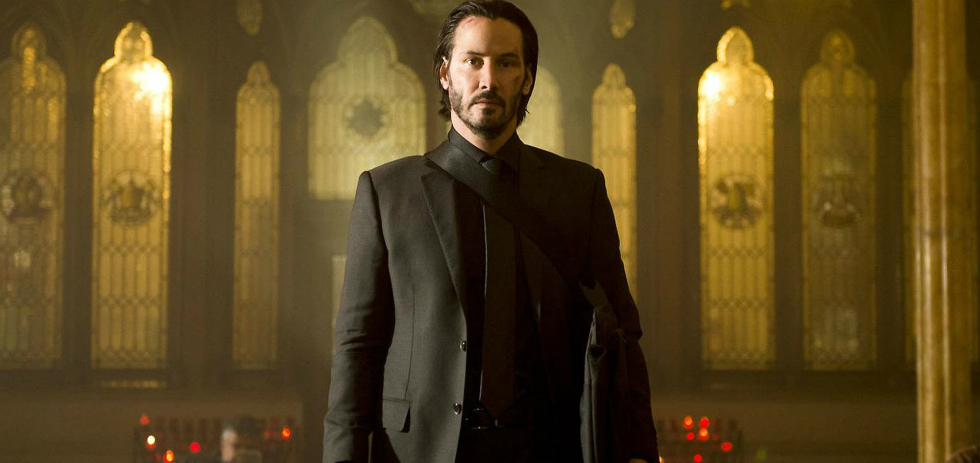
There’s a silent movie star magnetism to Keanu Reeves that’s long eluded the traditional rhetoric around his performances, in which stillness and intuition are mistaken for expressionless affect and stilted delivery. But as younger, more perceptive critics challenging these notions can attest, Reeves remains one of cinema’s most luminous presences, from his physical grace through his serene visage, whose features always seemed to transcend masculine heroism to herald an androgynous utopia. Director Chad Stahelski gets it: mid-way through his new John Wick: Chapter 2, there’s a superhuman shot capturing Reeves from low-angle in a European hotel, the wings of the establishment’s insignia spread out behind him like the angel that we don’t deserve.
2014’s John Wick was hailed — overpraised, even — for its lean, muscular action in an era that’d apparently forgotten those genre staples; at least in American cinema. It became a sleeper hit that even surfaced on the pop music landscape, and felt like movies might be figuring out what to do with Reeves once again. The sequel makes good on the hyperbole — more than just a great action film, it’s one of the best movies of the year.
Picking up right where chapter one left off, hitman Wick’s (Reeves) dead-wife-and-puppy vigilante rampage is coming back to bite him. After a torrid opening sequence in which Wick recovers his beloved muscle car from the gang who’d impounded it, he has his Architectural Digest home promptly blown apart as a way to drag him back into the assassination business. “I’m not that guy anymore,” Wick reluctantly protests to his former employers. “You’re always that guy, John,” comes the reply.
Wick checks his (now fully grown) new pooch into the hotel for assassin’s dogs and heads for Rome, where we first glimpse him prowling the ancient ruins in a sports coat and turtleneck — imagery enough to make one believe in the divine. His legend precedes him. “Are you here for the Pope?” asks Wick’s European contact, wondering if the pontiff’s date with the devil has arrived. There’s chapter three’s plotline taken care of, at least. We’re soon treated to a shopping montage involving high-end suit tailoring and an eerie arms dealer who seems to have been hired from the Overlook Hotel; a guy who offers Wick a gun smorgasbord like he’s serving a degustation meal.

The ensuing European escapade comes on like something out of a ’90s action movie, or at times a bizarro world giallo that’s found its way into a late-night cable remake. Wick dispatches his mark in an erotic-thriller Roman bath — holding his victim’s hand in a tender moment of compassion — before he’s engaged in hectic pursuit by her bodyguard (Common) and a mute assassin (Ruby Rose). The action circles a set piece at a decadent Italian rock concert a la MTV Europe circa 1994, the kind of blue-strobe-lit party where there’s a musician playing a guitar with a violin bow — and yes, Keanu gets to stage dive, his skills as Theodore Logan well intact.
Once again stunt man-turned-auteur Stahelski orchestrates scene after scene of gracefully choreographed carnage, his synchronicity with on-screen avatar Reeves — with whom he’s worked since The Matrix — apparent in every precisely blocked-out moment; less action dirges than ultra-violent ballet. There’s a thrilling chase underground through the Roman catacombs, where Stahelski and DP Dan Laustsen (Crimson Peak) achieve an astonishing clarity of movement despite the low light — the darkness punctuated by flashes of gunfire and search-party lights — and an endless rooftop brawl between Common and Reeves that ends in an amusingly deadpan conversation in a bar.
These matter-of-fact exchanges — no frills, just business — pile up into hilarious banalities that hover around the gunfire and bone cracking like another sound effect; words just noise to be discarded in the atmosphere. Reeves, meanwhile, intones his minimal dialogue as though he’s carrying an excruciating burden, often struggling to form words for the simplest of sentiments. As ever, he’s one step ahead of his detractors here: the inarticulate pauses are essential to the performance of his character, his glazed expression conveying an inscrutable secrecy. Recall Reeves’ much (erroneously) derided performance in Dracula — as a man out of time struggling to process the terror of the world, he’s the crystalline centre of the tumult around him.
Somewhat improbably, the film’s back half manages to up the ante after a price is put on Wick’s head, whereupon the action shifts to New York. On the run from a Mortal Kombat gallery of hired assassins, Wick’s flight through the city yields a bravura shootout at Lincoln Plaza, a chase through One World Trade and a brawl on the subway (the C train never seemed so exciting), evoking that great ’70s thriller tradition of locating tense encounters in iconic public spaces. Stahelski has an obvious love for all those ravishing, possibly accidental moments of eye candy that ornament the action genre — sometimes the contribution of unsung second unit teams — and delivers an embarrassment of riches here. Often these are clichés retooled to magic effect, like the climactic hall-of-mirrors showdown that pays tribute to both The Lady from Shanghai and The Man with the Golden Gun in its tableau of multiple Keanus stretched into infinity. And when Wick reconnects with an underground kingpin played by Laurence Fishburne — in full pigeon-hoarding Ghost Dog regalia — it feels like a homecoming for both the character and the actors.
Perhaps the film runs a touch long; like that gun shopping montage, it’s an exhausting full course and the dessert, however tasty, can be excessive — especially with a body count blowing out to ridiculous extremes. But who’s to complain? When Wick eventually retrieves his dog after the punishing run for his life, the pup’s caretaker assures him matter-of-factly: “He was a good dog. I enjoyed his company.” Truer words have never been spoken of a film.
